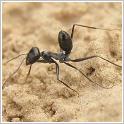Integrated sensing of movement and forces in a technical limb

Current planetary surface exploration rovers' navigation techniques mainly focus on visual stimulants. Typical visual navigation components (e.g. CCD-camera) are bulky and real-life tracking algorithms heavy on the processor unit.
In this project, we are trying to implement our knowledge of the way ants and some other insects count their steps and measure the strain in their campaniform sensillas to navigate through the terrain into robotics. This way we hope to come up with a navigation system that is not requiring a lot of processing power or space and is precise enough to keep track of our rovers.
Literature
- Pringle J.W.S., Proprioception in insects II. The action of the Campaniform Sensilla on the Legs, Department of Zoology, Cambridge, 1937
- Wehner R., The architecture of the desert ant's navigational toolkit (Hymenoptera: Formicidae), 2008
- Wittlinger et al., The Ant Odometer: Stepping on Stilts and Stumps, 2006
- Lin et al., Legged Odometry from Body Pose in a Hexapod Robot, Experimental Robotics IX, STAR 21, p. 439-448, 2006